Functions and algebra: Use a variety of techniques to sketch and interpret information from graphs of functions
Unit 7: The sine function
Dylan Busa
Unit 7 outcomes
By the end of this unit you will be able to:
- Sketch functions of the form [latex]\scriptsize y=a\sin k\theta[/latex].
- Determine the effects of [latex]\scriptsize a[/latex] and [latex]\scriptsize k[/latex] on the sine graph of the form [latex]\scriptsize y=a\sin k\theta[/latex].
- Find the values of [latex]\scriptsize a[/latex] and [latex]\scriptsize k[/latex] from a given sine graph of the form [latex]\scriptsize y=a\sin k\theta[/latex].
Remember that the domain of trigonometric functions can be represented as [latex]\scriptsize x[/latex] or [latex]\scriptsize \theta[/latex]. Therefore, [latex]\scriptsize y=\sin x[/latex] and [latex]\scriptsize y=\sin \theta[/latex] are the same function.
What you should know
Before you start this unit, make sure you can:
- Sketch sine functions of the form [latex]\scriptsize y=a\sin \theta +q[/latex]. Refer to level 2 subject outcome 2.1 Unit 5 if you need help with this.
Introduction
The three basic trigonometric functions, sine, cosine and tangent, are different from the other functions which we study in that they repeat themselves again and again. We call this behaviour periodicity. After one period, the graph repeats itself. The period of the basic sine function, [latex]\scriptsize y=\sin \theta[/latex], is [latex]\scriptsize {{360}^\circ}[/latex]. The function values repeat themselves every [latex]\scriptsize {{360}^\circ}[/latex] (see Figure 1).
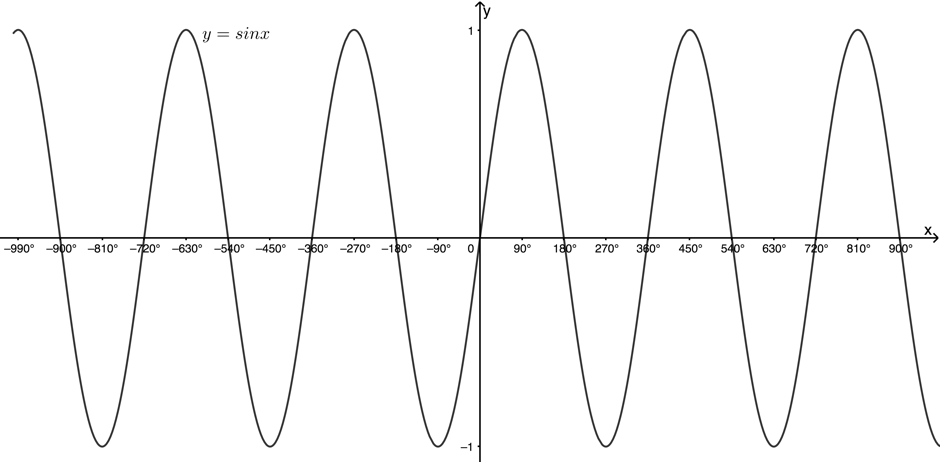
Note
If you have an internet connection, spend some time playing with this online simulation to make sure that you understand why the period of the sine function is [latex]\scriptsize {{360}^\circ}[/latex] (one full revolution of the unit circle).
The same is true for the cosine function. The period of [latex]\scriptsize y=\cos \theta[/latex], is [latex]\scriptsize {{360}^\circ}[/latex] (see Figure 2).
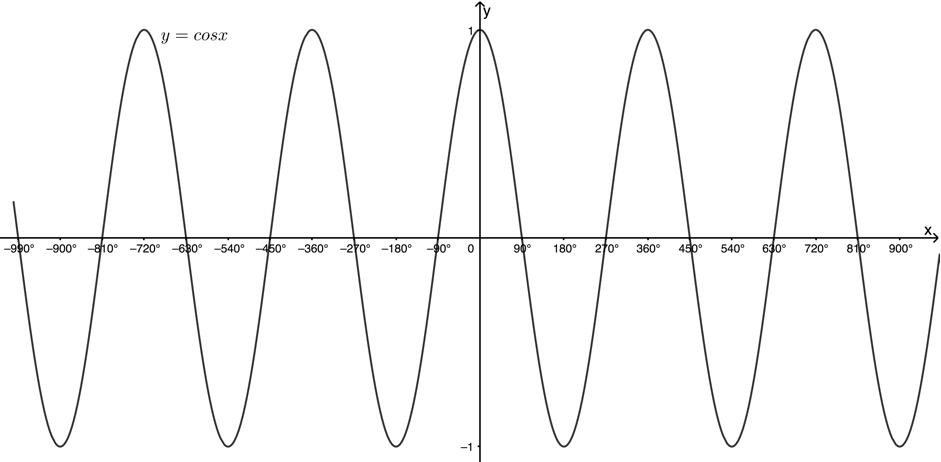
The period of [latex]\scriptsize y=\tan \theta[/latex], is [latex]\scriptsize {{180}^\circ}[/latex].The function values repeat themselves every [latex]\scriptsize {{180}^\circ}[/latex] (see Figure 3).
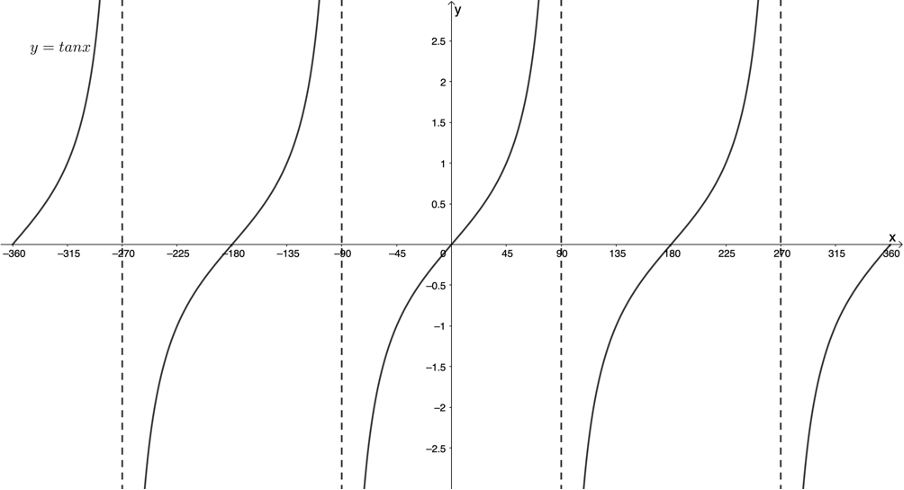
As we learnt in level 2 subject outcome 2.1 unit 5, this periodicity makes the trigonometric functions, and especially sine and cosine, particularly useful in modelling things such as sound waves.
The other feature of the sine and cosine functions that is unique among the functions we have studied is the fact that they have a specific amplitude. Amplitude is the maximum distance between the function and its midline. The amplitude of [latex]\scriptsize y=\sin \theta[/latex] is [latex]\scriptsize 1[/latex] (see Figure 4) and the amplitude of [latex]\scriptsize y=\cos \theta[/latex] is also [latex]\scriptsize 1[/latex] (see Figure 5).
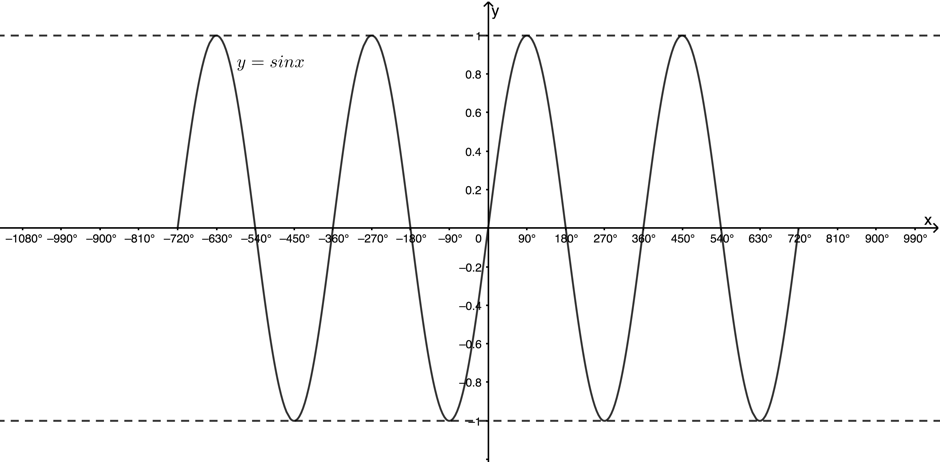
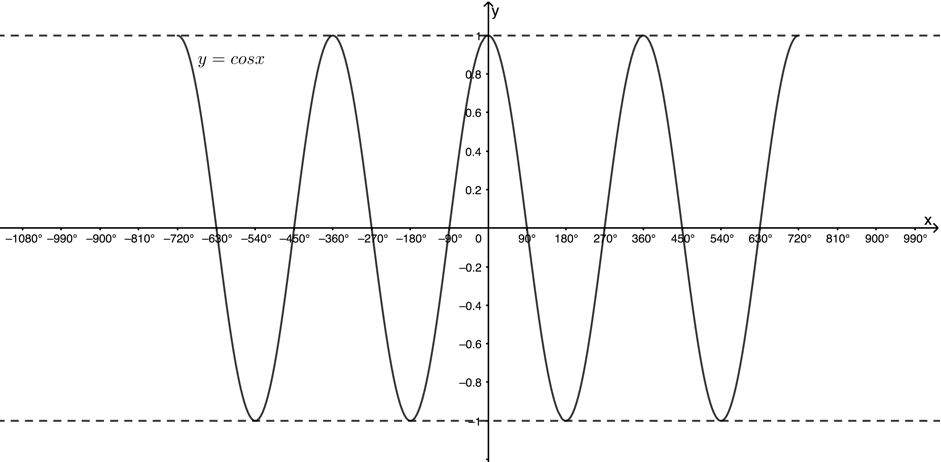
Figure 5: [latex]\scriptsize y=\cos x,-{{720}^\circ}\le x\le 720{}^\circ[/latex]In [latex]\scriptsize y=\sin \theta[/latex], because the amplitude is [latex]\scriptsize 1[/latex] and the graph’s midline is the x-axis, the maximum value of [latex]\scriptsize y=\sin \theta[/latex] is [latex]\scriptsize 1[/latex] and the minimum value is [latex]\scriptsize -1[/latex]. In the interval [latex]\scriptsize {{0}^\circ}\le \theta \le {{360}^\circ}[/latex], the graph of [latex]\scriptsize y=\sin \theta[/latex] has a maximum turning point at [latex]\scriptsize ({{90}^\circ},1)[/latex] and a minimum turning point at [latex]\scriptsize ({{270}^\circ},-1)[/latex] (see Figure 6).
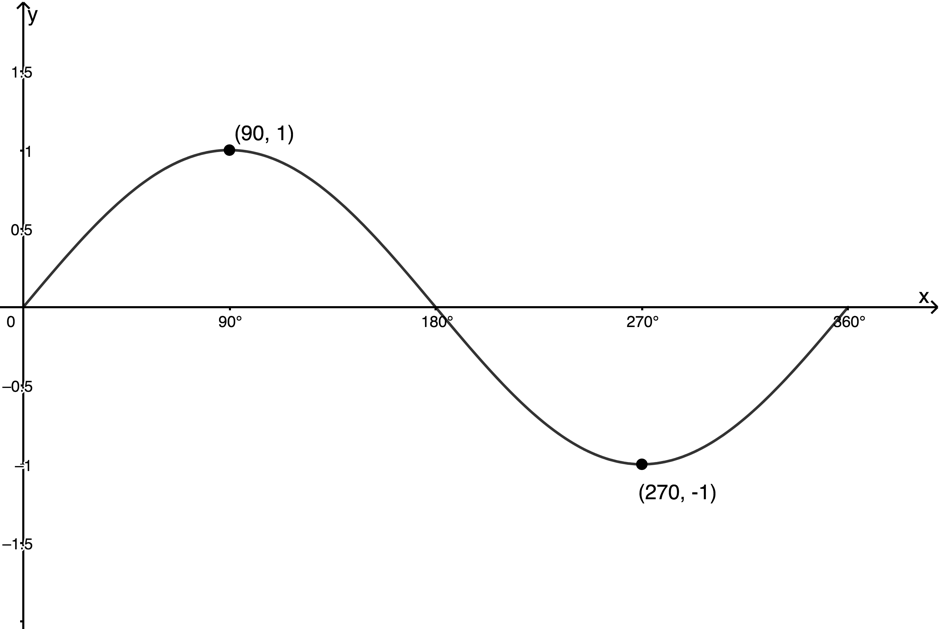
In level 2 we were introduced to the sine function of the form [latex]\scriptsize y=a\sin \theta +q[/latex]. We discovered that the value of [latex]\scriptsize q[/latex] shifted the graph vertically up and down while the value of [latex]\scriptsize a[/latex] changed the amplitude of the graph.
Take note!
Period of [latex]\scriptsize y=a\sin \theta +q[/latex] is [latex]\scriptsize {{360}^\circ}[/latex].
The effect of [latex]\scriptsize q[/latex]:
- if [latex]\scriptsize q \gt 0[/latex], the function is shifted up by [latex]\scriptsize q[/latex] units
- if [latex]\scriptsize q \lt 0[/latex], the function is shifted down by [latex]\scriptsize q[/latex] units.
The effect of [latex]\scriptsize a[/latex]:
- if [latex]\scriptsize a \gt 1[/latex], the amplitude increases to [latex]\scriptsize a[/latex]
- if [latex]\scriptsize 0 \lt a \lt 1[/latex], the amplitude decreases to [latex]\scriptsize a[/latex]
- if [latex]\scriptsize a \lt 0[/latex], the function is reflected about the x-axis
- if [latex]\scriptsize a \lt -1[/latex], the amplitude increases to [latex]\scriptsize a[/latex]
- if [latex]\scriptsize -1 \lt a \lt 0[/latex], the amplitude decreases to [latex]\scriptsize a[/latex].
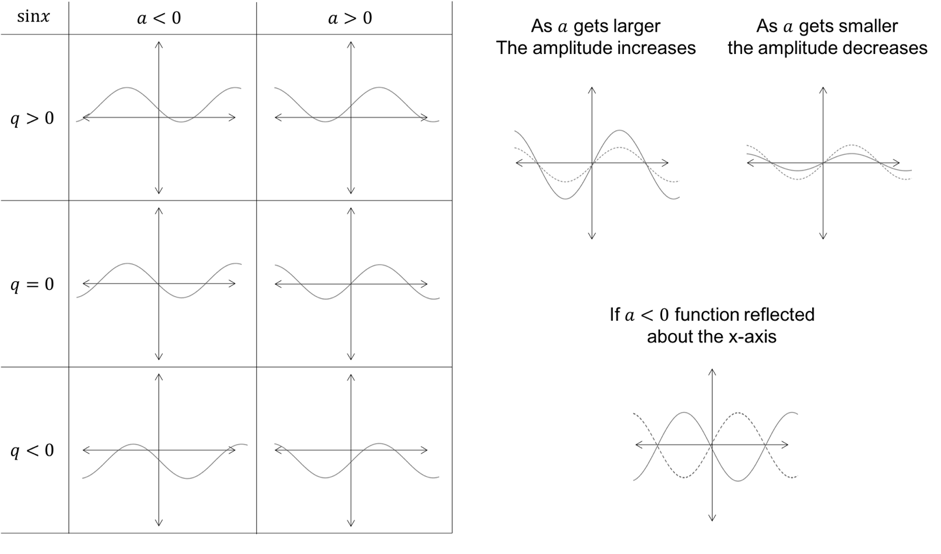
Note
If you have access to the internet, visit this interactive simulation.
Here you will find a sine function of the form [latex]\scriptsize y=a\sin x+q[/latex] with sliders to change the values of [latex]\scriptsize a[/latex] and [latex]\scriptsize q[/latex]. Spend some time playing with it to make sure that you understand how changing the values of [latex]\scriptsize a[/latex] and [latex]\scriptsize q[/latex] affects the shape and location of the sine function of the form [latex]\scriptsize y=a\sin x+q[/latex].
The sine function of the form [latex]\scriptsize y=\sin kx[/latex]
By now, you should have a good understanding of the effects of [latex]\scriptsize a[/latex] and [latex]\scriptsize q[/latex] on [latex]\scriptsize y=a\sin x+q[/latex]. But what happens if we change the form of the function to [latex]\scriptsize y=\sin kx[/latex]. We know that the period of the ‘normal’ sine function [latex]\scriptsize y=\sin x[/latex] is [latex]\scriptsize {{360}^\circ}[/latex]. How does the value of [latex]\scriptsize k[/latex] in [latex]\scriptsize y=\sin kx[/latex] change the shape of the graph?
Activity 7.1: What is the period?
Time required: 40 minutes
What you need:
- a pen or pencil
- a calculator
- several pieces of paper
What to do:
- Start by making a sketch of [latex]\scriptsize y=\sin x[/latex] for the interval [latex]\scriptsize -{{360}^\circ}\le x\le {{360}^\circ}[/latex] on a piece of paper. If you need to, you can complete the following table of values first.
[latex]\scriptsize x[/latex] [latex]\scriptsize -{{360}^\circ}[/latex] [latex]\scriptsize -{{270}^\circ}[/latex] [latex]\scriptsize -{{180}^\circ}[/latex] [latex]\scriptsize -{{90}^\circ}[/latex] [latex]\scriptsize {{0}^\circ}[/latex] [latex]\scriptsize {{90}^\circ}[/latex] [latex]\scriptsize {{180}^\circ}[/latex] [latex]\scriptsize {{270}^\circ}[/latex] [latex]\scriptsize {{360}^\circ}[/latex] [latex]\scriptsize \sin x[/latex] - Now complete the following tables of values and sketch the additional functions on separate sets of axes for the interval [latex]\scriptsize -{{360}^\circ}\le x\le {{360}^\circ}[/latex]. Just make sure that you use the same scale for each set of axes so that you can compare the graphs.
[latex]\scriptsize x[/latex] [latex]\scriptsize -{{180}^\circ}[/latex] [latex]\scriptsize -{{135}^\circ}[/latex] [latex]\scriptsize -{{90}^\circ}[/latex] [latex]\scriptsize -{{45}^\circ}[/latex] [latex]\scriptsize {{0}^\circ}[/latex] [latex]\scriptsize {{45}^\circ}[/latex] [latex]\scriptsize {{90}^\circ}[/latex] [latex]\scriptsize {{135}^\circ}[/latex] [latex]\scriptsize {{180}^\circ}[/latex] [latex]\scriptsize \sin \left( {2x} \right)[/latex] [latex]\scriptsize x[/latex] [latex]\scriptsize -{{360}^\circ}[/latex] [latex]\scriptsize -{{270}^\circ}[/latex] [latex]\scriptsize -{{180}^\circ}[/latex] [latex]\scriptsize -{{90}^\circ}[/latex] [latex]\scriptsize {{0}^\circ}[/latex] [latex]\scriptsize {{90}^\circ}[/latex] [latex]\scriptsize {{180}^\circ}[/latex] [latex]\scriptsize {{270}^\circ}[/latex] [latex]\scriptsize {{360}^\circ}[/latex] [latex]\scriptsize \sin \left( {\displaystyle \frac{1}{2}x} \right)[/latex] [latex]\scriptsize \sin \left( {-x} \right)[/latex] - Use your sketches to complete the following table.
Domain Range Amplitude Period [latex]\scriptsize y=\sin x[/latex] [latex]\scriptsize y=\sin \left( {2x} \right)[/latex] [latex]\scriptsize y=\sin \left( {\displaystyle \frac{1}{2}x} \right)[/latex] [latex]\scriptsize y=\sin \left( {-x} \right)[/latex] - Using the results of the table you completed in step 3, describe the effect of [latex]\scriptsize k[/latex] on the graph of the function [latex]\scriptsize y=\sin kx[/latex].
What did you find?
- Below is the completed table of values and the sketch of [latex]\scriptsize y=\sin x,\text{ for the interval}-{{360}^\circ}\le x\le {{360}^\circ}[/latex] (see Figure 8).
[latex]\scriptsize x[/latex] [latex]\scriptsize -{{360}^\circ}[/latex] [latex]\scriptsize -{{270}^\circ}[/latex] [latex]\scriptsize -{{180}^\circ}[/latex] [latex]\scriptsize -{{90}^\circ}[/latex] [latex]\scriptsize {{0}^\circ}[/latex] [latex]\scriptsize {{90}^\circ}[/latex] [latex]\scriptsize {{180}^\circ}[/latex] [latex]\scriptsize {{270}^\circ}[/latex] [latex]\scriptsize {{360}^\circ}[/latex] [latex]\scriptsize \sin x[/latex] [latex]\scriptsize 0[/latex] [latex]\scriptsize 1[/latex] [latex]\scriptsize 0[/latex] [latex]\scriptsize -1[/latex] [latex]\scriptsize 0[/latex] [latex]\scriptsize 1[/latex] [latex]\scriptsize 0[/latex] [latex]\scriptsize -1[/latex] [latex]\scriptsize 0[/latex] .

Figure 8: Graph of [latex]\scriptsize y=\sin x,-{{360}^\circ}\le x\le {{360}^\circ}[/latex] - Here are the completed tables of values for the other functions.
[latex]\scriptsize x[/latex] [latex]\scriptsize -{{180}^\circ}[/latex] [latex]\scriptsize -{{135}^\circ}[/latex] [latex]\scriptsize -{{90}^\circ}[/latex] [latex]\scriptsize -{{45}^\circ}[/latex] [latex]\scriptsize {{0}^\circ}[/latex] [latex]\scriptsize {{45}^\circ}[/latex] [latex]\scriptsize {{90}^\circ}[/latex] [latex]\scriptsize {{135}^\circ}[/latex] [latex]\scriptsize {{180}^\circ}[/latex] [latex]\scriptsize \sin \left( {2x} \right)[/latex] [latex]\scriptsize 0[/latex] [latex]\scriptsize 1[/latex] [latex]\scriptsize 0[/latex] [latex]\scriptsize -1[/latex] [latex]\scriptsize 0[/latex] [latex]\scriptsize 1[/latex] [latex]\scriptsize 0[/latex] [latex]\scriptsize -1[/latex] [latex]\scriptsize 0[/latex] [latex]\scriptsize x[/latex] [latex]\scriptsize -{{360}^\circ}[/latex] [latex]\scriptsize -{{270}^\circ}[/latex] [latex]\scriptsize -{{180}^\circ}[/latex] [latex]\scriptsize -{{90}^\circ}[/latex] [latex]\scriptsize {{0}^\circ}[/latex] [latex]\scriptsize {{90}^\circ}[/latex] [latex]\scriptsize {{180}^\circ}[/latex] [latex]\scriptsize {{270}^\circ}[/latex] [latex]\scriptsize {{360}^\circ}[/latex] [latex]\scriptsize \sin \left( {\displaystyle \frac{1}{2}x} \right)[/latex] [latex]\scriptsize 0[/latex] [latex]\scriptsize -0.707[/latex] [latex]\scriptsize -1[/latex] [latex]\scriptsize -0.707[/latex] [latex]\scriptsize 0[/latex] [latex]\scriptsize 0.707[/latex] [latex]\scriptsize 1[/latex] [latex]\scriptsize 0.707[/latex] [latex]\scriptsize 0[/latex] [latex]\scriptsize \sin \left( {-x} \right)[/latex] [latex]\scriptsize 0[/latex] [latex]\scriptsize -1[/latex] [latex]\scriptsize 0[/latex] [latex]\scriptsize 1[/latex] [latex]\scriptsize 0[/latex] [latex]\scriptsize -1[/latex] [latex]\scriptsize 0[/latex] [latex]\scriptsize 1[/latex] [latex]\scriptsize 0[/latex] Below the graphs of [latex]\scriptsize y=\sin (2x)[/latex] (see Figure 9), [latex]\scriptsize y=\sin \left( {\displaystyle \frac{1}{2}x} \right)[/latex] (see Figure 10) and [latex]\scriptsize y=\sin (-x)[/latex] (see Figure 11) are drawn for the interval [latex]\scriptsize -{{360}^\circ}\le x\le {{360}^\circ}[/latex]. For ease of comparison with [latex]\scriptsize y=\sin x[/latex], the graph of [latex]\scriptsize y=\sin x[/latex] has also been included as the dotted line.

Figure 9: Graph of [latex]\scriptsize y=\sin (2x),\text{ }-{{360}^\circ}\le x\le {{360}^\circ}[/latex] 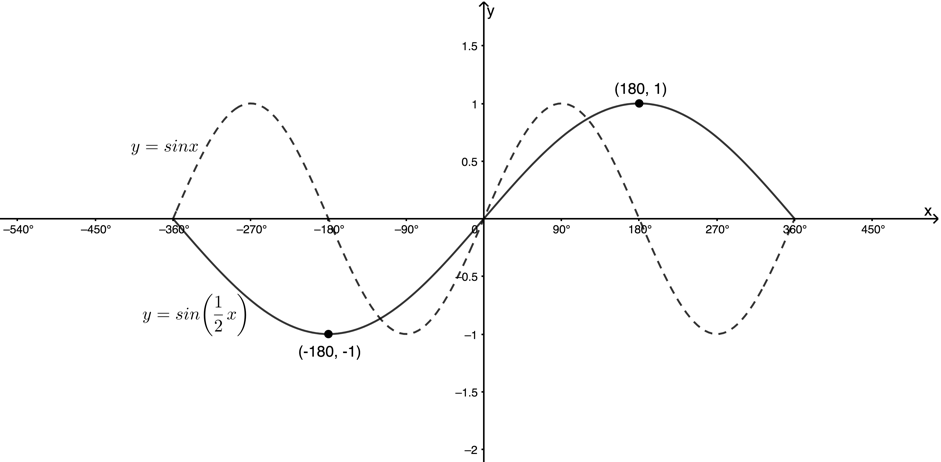
Figure 10: Graph of [latex]\scriptsize y=\sin \left( {\displaystyle \frac{1}{2}x} \right),\text{ }-{{360}^\circ}\le x\le {{360}^\circ}[/latex] 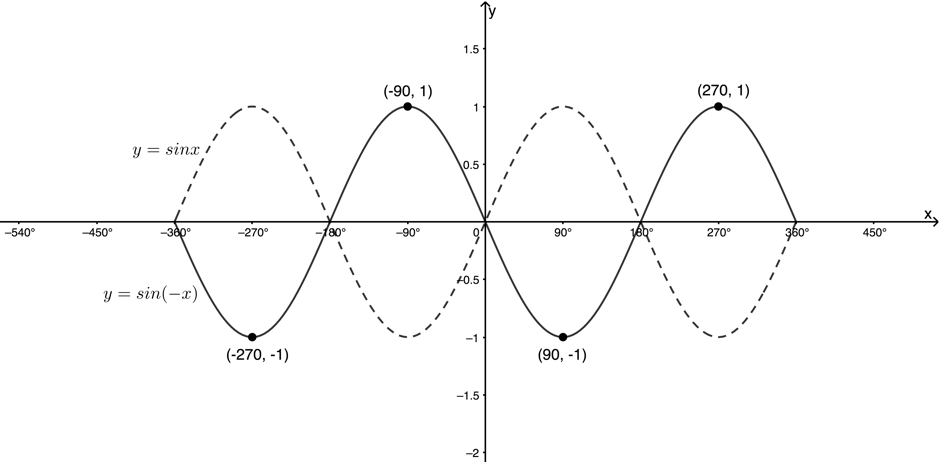
Figure 11: Graph of [latex]\scriptsize y=\sin (-x),\text{ }-{{360}^\circ}\le x\le {{360}^\circ}[/latex] - Here is the completed comparison table.
Domain Range Amplitude Period [latex]\scriptsize y=\sin x[/latex] [latex]\scriptsize \{x|x\in \mathbb{R},-{{360}^\circ}\le x\le {{360}^\circ}\}\text{ }[/latex] [latex]\scriptsize \{y|y\in \mathbb{R},-1\le y\le 1\}\text{ }[/latex] [latex]\scriptsize 1[/latex] [latex]\scriptsize {{360}^\circ}[/latex] [latex]\scriptsize y=\sin \left( {2x} \right)[/latex] [latex]\scriptsize \{x|x\in \mathbb{R},-{{360}^\circ}\le x\le {{360}^\circ}\}\text{ }[/latex] [latex]\scriptsize \{y|y\in \mathbb{R},-1\le y\le 1\}\text{ }[/latex] [latex]\scriptsize 1[/latex] [latex]\scriptsize {{180}^\circ}[/latex] [latex]\scriptsize y=\sin \left( {\displaystyle \frac{1}{2}x} \right)[/latex] [latex]\scriptsize \{x|x\in \mathbb{R},-{{360}^\circ}\le x\le {{360}^\circ}\}\text{ }[/latex] [latex]\scriptsize \{y|y\in \mathbb{R},-1\le y\le 1\}\text{ }[/latex] [latex]\scriptsize 1[/latex] [latex]\scriptsize {{720}^\circ}[/latex] [latex]\scriptsize y=\sin \left( {-x} \right)[/latex] [latex]\scriptsize \{x|x\in \mathbb{R},-{{360}^\circ}\le x\le {{360}^\circ}\}\text{ }[/latex] [latex]\scriptsize \{y|y\in \mathbb{R},-1\le y\le 1\}\text{ }[/latex] [latex]\scriptsize 1[/latex] [latex]\scriptsize {{360}^\circ}[/latex] - We can see from the sketches that the value of [latex]\scriptsize k[/latex] in [latex]\scriptsize y=\sin kx[/latex] does NOT affect the domain, range or amplitude of the graph. It does, however, affect the period of the graph. The period of the graph when:
- [latex]\scriptsize k=1[/latex] is [latex]\scriptsize {{360}^\circ}[/latex]
- [latex]\scriptsize k=2[/latex] is [latex]\scriptsize \displaystyle \frac{{{{{360}}^\circ}}}{2}={{180}^\circ}[/latex]
- [latex]\scriptsize k=\displaystyle \frac{1}{2}[/latex] is [latex]\scriptsize \displaystyle \frac{{{{{360}}^\circ}}}{{\displaystyle \frac{1}{2}}}={{360}^\circ}\times 2={{720}^\circ}[/latex]
- [latex]\scriptsize k=-1[/latex] is [latex]\scriptsize {{360}^\circ}[/latex] but the graph is reflected about the x-axis. In other words [latex]\scriptsize \sin (-x)=-\sin (x)[/latex].
From Activity 7.1 we can see that the value of [latex]\scriptsize k[/latex] in [latex]\scriptsize y=\sin kx[/latex] affects the period of the function and that we can calculate the period as [latex]\scriptsize \text{period}=\displaystyle \frac{{{{{360}}^\circ}}}{{\left| k \right|}}[/latex] where [latex]\scriptsize \text{ }\left| k \right|[/latex] is the absolute value of [latex]\scriptsize k[/latex], in other words the positive value of [latex]\scriptsize k[/latex]. This means that if [latex]\scriptsize k \gt 1[/latex], the period decreases and if [latex]\scriptsize 0 \lt k \lt 1[/latex], the period increases.
If [latex]\scriptsize k \lt 0[/latex], it changes the period AND reflects the graph about the x-axis because [latex]\scriptsize \sin (-x)=-\sin (x)[/latex].
Take note!
In [latex]\scriptsize y=\sin kx[/latex] the [latex]\scriptsize \text{Period}=\displaystyle \frac{{{{{360}}^\circ}}}{{\left| k \right|}}[/latex].
[latex]\scriptsize \sin (-x)=-\sin (x)[/latex]. Therefore, if [latex]\scriptsize k \lt 0[/latex], it changes the period AND reflects the graph about the x-axis.

Example 7.1
Given the function [latex]\scriptsize y=\sin \left( {\displaystyle \frac{{3x}}{2}} \right)[/latex] for the interval [latex]\scriptsize {{0}^\circ}\le x\le {{360}^\circ}[/latex], determine the:
- domain and range
- period.
Solution
- Domain: [latex]\scriptsize \{x|x\in \mathbb{R},{{0}^\circ}\le x\le {{360}^\circ}\}\text{ }[/latex]
Range: [latex]\scriptsize \{y|y\in \mathbb{R},-1\le y\le 1\}\text{ }[/latex] - [latex]\scriptsize k=\displaystyle \frac{3}{2}[/latex]. Therefore, the period of the graph is [latex]\scriptsize \displaystyle \frac{{{{{360}}^\circ}}}{{\left| {\displaystyle \frac{3}{2}} \right|}}=\displaystyle \frac{{2\times {{{360}}^\circ}}}{3}={{240}^\circ}[/latex].
Exercise 7.1
- Determine the periods of the following functions:
- [latex]\scriptsize y=\sin (3x)[/latex]
- [latex]\scriptsize y=\sin \left( {-\displaystyle \frac{1}{2}x} \right)[/latex]
- [latex]\scriptsize y=\sin \left( {\displaystyle \frac{7}{3}x} \right)[/latex]
- For each function of the form [latex]\scriptsize y=\sin kx[/latex] below, determine the value of [latex]\scriptsize k[/latex].
- .
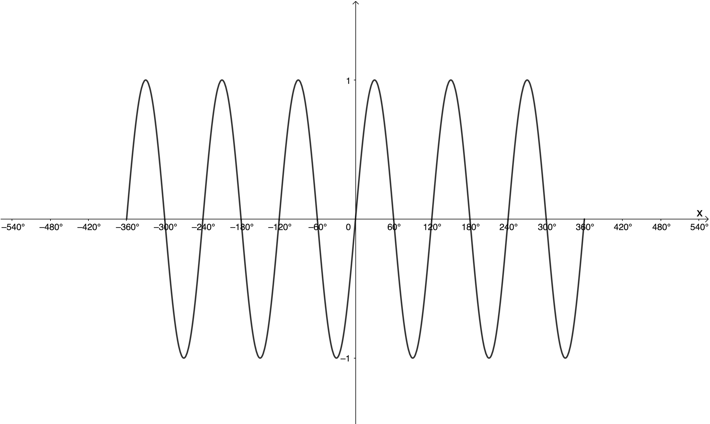
- .
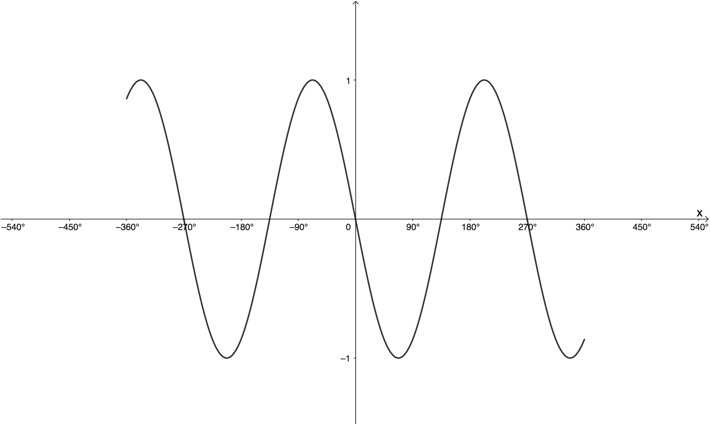
- .
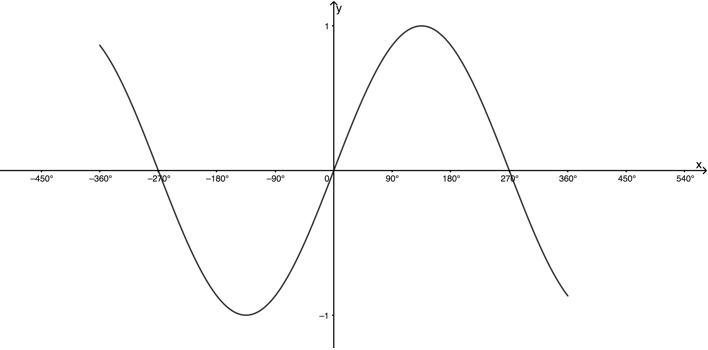
- .
The full solutions are at the end of the unit.
Sketch functions of the form [latex]\scriptsize y=a\sin kx[/latex]
Now that we know that the value of [latex]\scriptsize k[/latex] affects the period of the function [latex]\scriptsize y=\sin kx[/latex], we can combine this with our knowledge of the effects of [latex]\scriptsize a[/latex] and examine functions of the form [latex]\scriptsize y=a\sin kx[/latex].
The effects of [latex]\scriptsize a[/latex] on [latex]\scriptsize y=a\sin kx[/latex] are exactly the same as they were on [latex]\scriptsize y=a\sin x+q[/latex]. Before we learn how to sketch functions of the form [latex]\scriptsize y=a\sin kx[/latex], spend some time playing with this online simulation.
Here you will find a graph of the form [latex]\scriptsize \displaystyle y=a\sin kx[/latex] with sliders to change the values of [latex]\scriptsize a[/latex] and [latex]\scriptsize k[/latex]. As you change these values look at the effect this has on the amplitude and/or the period.
Now open this interactive simulation.
Here you will find a graph of the function [latex]\scriptsize \displaystyle y=a\sin kx+q[/latex] for the interval [latex]\scriptsize -{{360}^\circ}\le x\le {{360}^\circ}[/latex]. Pay particular attention to how the amplitude, period and the values of the turning points and intercepts with the axes change as you change the values of [latex]\scriptsize a[/latex] [latex]\scriptsize k[/latex] and [latex]\scriptsize q[/latex].
The best way to sketch functions of the form [latex]\scriptsize y=a\sin kx[/latex] is to transform the basic function of [latex]\scriptsize y=\sin x[/latex] depending on the values of [latex]\scriptsize a[/latex] and [latex]\scriptsize k[/latex]. To do this, you need to know the set of ‘anchor points’ of [latex]\scriptsize y=\sin x[/latex], as transformation of these points will help you to sketch functions of the form [latex]\scriptsize y=a\sin kx[/latex].
Take note!
The ‘anchor points’ for [latex]\scriptsize y=\sin x[/latex] are illustrated in Figure 13 for the interval [latex]\scriptsize -{{360}^\circ}\le x\le {{360}^\circ}[/latex].

Example 7.2
Sketch the function [latex]\scriptsize y=2\sin 2x[/latex] for the interval [latex]\scriptsize -{{180}^\circ}\le x\le {{180}^\circ}[/latex].
Solution
The function is of the form [latex]\scriptsize y=a\sin kx[/latex] with [latex]\scriptsize a=2[/latex] and [latex]\scriptsize k=2[/latex].
Because [latex]\scriptsize k=2[/latex], we know that the period of the function will be [latex]\scriptsize \displaystyle \frac{{{{{360}}^\circ}}}{{\left| 2 \right|}}={{180}^\circ}[/latex]. We need to transform one period of ‘anchor points’ as follows:
| [latex]\scriptsize \sin x[/latex] | [latex]\scriptsize ({{0}^\circ},0)[/latex] | [latex]\scriptsize ({{90}^\circ},1)[/latex] | [latex]\scriptsize ({{180}^\circ},0)[/latex] | [latex]\scriptsize ({{270}^\circ},-1)[/latex] | [latex]\scriptsize ({{360}^\circ},0)[/latex] |
| [latex]\scriptsize \sin 2x[/latex] | [latex]\scriptsize ({{0}^\circ},0)[/latex] | [latex]\scriptsize ({{45}^\circ},1)[/latex] | [latex]\scriptsize ({{90}^\circ},0)[/latex] | [latex]\scriptsize ({{135}^\circ},-1)[/latex] | [latex]\scriptsize ({{180}^\circ},0)[/latex] |
Because the period has been halved, the value of each of the x-coordinates is also halved. We can see that the function will start at zero, rise to its maximum turning point [latex]\scriptsize ({{45}^\circ},1)[/latex] , fall back to zero, fall to its minimum turning point [latex]\scriptsize ({{135}^\circ},-1)[/latex] and rise back to zero in [latex]\scriptsize {{180}^\circ}[/latex], the new period.
Because [latex]\scriptsize a=2[/latex], we know that each function value (or y-value) is going to be multiplied by [latex]\scriptsize 2[/latex] thereby making the amplitude of the function [latex]\scriptsize 2[/latex]. We need to further transform one period of ‘anchor points’ as follows:
| [latex]\scriptsize \sin x[/latex] | [latex]\scriptsize ({{0}^\circ},0)[/latex] | [latex]\scriptsize ({{90}^\circ},1)[/latex] | [latex]\scriptsize ({{180}^\circ},0)[/latex] | [latex]\scriptsize ({{270}^\circ},-1)[/latex] | [latex]\scriptsize ({{360}^\circ},0)[/latex] |
| [latex]\scriptsize \sin 2x[/latex] | [latex]\scriptsize ({{0}^\circ},0)[/latex] | [latex]\scriptsize ({{45}^\circ},1)[/latex] | [latex]\scriptsize ({{90}^\circ},0)[/latex] | [latex]\scriptsize ({{135}^\circ},-1)[/latex] | [latex]\scriptsize ({{180}^\circ},0)[/latex] |
| [latex]\scriptsize 2\sin 2x[/latex] | [latex]\scriptsize ({{0}^\circ},0)[/latex] | [latex]\scriptsize ({{45}^\circ},2)[/latex] | [latex]\scriptsize ({{90}^\circ},0)[/latex] | [latex]\scriptsize ({{135}^\circ},-2)[/latex] | [latex]\scriptsize ({{180}^\circ},0)[/latex] |
We can see that the function will start at zero, rise to its new maximum turning point [latex]\scriptsize ({{45}^\circ},2)[/latex] , fall back to zero, fall to its new minimum turning point [latex]\scriptsize ({{135}^\circ},-2)[/latex] and rise back to zero in [latex]\scriptsize {{180}^\circ}[/latex], the new period.
We can now plot our transformed ‘anchor points’ and draw the graph. We first draw it for the interval [latex]\scriptsize {{0}^\circ}\le x\le {{180}^\circ}[/latex] and then continue to pattern for the full interval of [latex]\scriptsize -{{180}^\circ}\le x\le {{180}^\circ}[/latex].
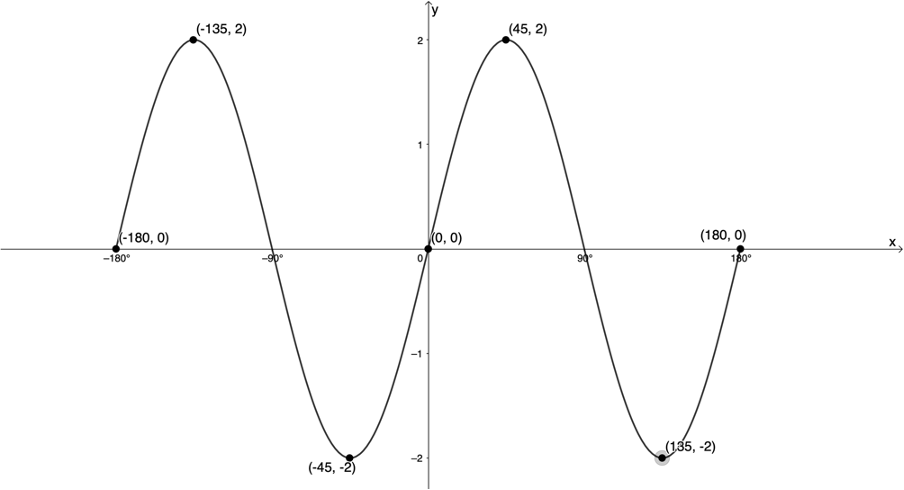
Example 7.3
Given the function [latex]\scriptsize f(x)=3\sin \left( {-\displaystyle \frac{1}{2}x} \right)[/latex].
- Sketch the graph of [latex]\scriptsize f(x)[/latex] for the interval [latex]\scriptsize -{{360}^\circ}\le x\le {{360}^\circ}[/latex].
- State the domain and range of [latex]\scriptsize f(x)[/latex].
- List the turning points of [latex]\scriptsize f(x)[/latex].
- What is the amplitude of [latex]\scriptsize f(x)[/latex]?
- What is the period of [latex]\scriptsize f(x)[/latex]?
Solutions
- The function is of the form [latex]\scriptsize y=a\sin kx[/latex] Therefore, [latex]\scriptsize a=3[/latex] and [latex]\scriptsize k=-\displaystyle \frac{1}{2}[/latex].
.
Because [latex]\scriptsize k=-\displaystyle \frac{1}{2}[/latex], we know that the period of the function will be [latex]\scriptsize \displaystyle \frac{{{{{360}}^\circ}}}{{\left| {-\displaystyle \frac{1}{2}} \right|}}=\displaystyle \frac{{{{{360}}^\circ}}}{{\displaystyle \frac{1}{2}}}={{720}^\circ}[/latex].But [latex]\scriptsize k \lt 0[/latex] and we know that [latex]\scriptsize \sin (-x)=-\sin x[/latex]. Therefore, we need to multiply the x-values of the ‘anchor points’ by [latex]\scriptsize 2[/latex] for the new period and multiply the y-values of the ‘anchor points’ by [latex]\scriptsize -1[/latex] to reflect the fact that [latex]\scriptsize k \lt 0[/latex].
.
We need to transform one period of ‘anchor points’ as follows:[latex]\scriptsize \sin x[/latex] [latex]\scriptsize ({{0}^\circ},0)[/latex] [latex]\scriptsize ({{90}^\circ},1)[/latex] [latex]\scriptsize ({{180}^\circ},0)[/latex] [latex]\scriptsize ({{270}^\circ},-1)[/latex] [latex]\scriptsize ({{360}^\circ},0)[/latex] [latex]\scriptsize \sin \left( {-\displaystyle \frac{1}{2}x} \right)[/latex] [latex]\scriptsize ({{0}^\circ},0)[/latex] [latex]\scriptsize ({{180}^\circ},-1)[/latex] [latex]\scriptsize ({{360}^\circ},0)[/latex] [latex]\scriptsize ({{540}^\circ},1)[/latex] [latex]\scriptsize ({{720}^\circ},0)[/latex] .
Because the period has been doubled, the value of each of the x-coordinates is also doubled. We can see that the function will start at zero, drop to its minimum turning point [latex]\scriptsize ({{180}^\circ},-1)[/latex] , rise back to zero, rise to its maximum turning point [latex]\scriptsize ({{540}^\circ},-1)[/latex] and fall back to zero in [latex]\scriptsize {{720}^\circ}[/latex], the new period.
.
Because [latex]\scriptsize a=3[/latex], we know that each function value (or y-value) is going to be multiplied by [latex]\scriptsize 3[/latex] thereby making the amplitude of the function [latex]\scriptsize 3[/latex]. We need to further transform one period of ‘anchor points’ as follows:[latex]\scriptsize \sin x[/latex] [latex]\scriptsize ({{0}^\circ},0)[/latex] [latex]\scriptsize ({{90}^\circ},1)[/latex] [latex]\scriptsize ({{180}^\circ},0)[/latex] [latex]\scriptsize ({{270}^\circ},-1)[/latex] [latex]\scriptsize ({{360}^\circ},0)[/latex] [latex]\scriptsize \sin \left( {-\displaystyle \frac{1}{2}x} \right)[/latex] [latex]\scriptsize ({{0}^\circ},0)[/latex] [latex]\scriptsize ({{180}^\circ},-1)[/latex] [latex]\scriptsize ({{360}^\circ},0)[/latex] [latex]\scriptsize ({{540}^\circ},1)[/latex] [latex]\scriptsize ({{720}^\circ},0)[/latex] [latex]\scriptsize 3\sin \left( {-\displaystyle \frac{1}{2}x} \right)[/latex] [latex]\scriptsize ({{0}^\circ},0)[/latex] [latex]\scriptsize ({{180}^\circ},-3)[/latex] [latex]\scriptsize ({{360}^\circ},0)[/latex] [latex]\scriptsize ({{540}^\circ},3)[/latex] [latex]\scriptsize ({{720}^\circ},0)[/latex] .
We can see that the function will start at zero, fall to its new minimum turning point [latex]\scriptsize ({{180}^\circ},-3)[/latex] , rise back to zero, rise to its new maximum turning point [latex]\scriptsize ({{540}^\circ},3)[/latex]and fall back to zero in [latex]\scriptsize {{720}^\circ}[/latex], the new period.
.
We can now plot our transformed ‘anchor points’ and draw the graph for the interval [latex]\scriptsize -{{360}^\circ}\le x\le {{360}^\circ}[/latex].
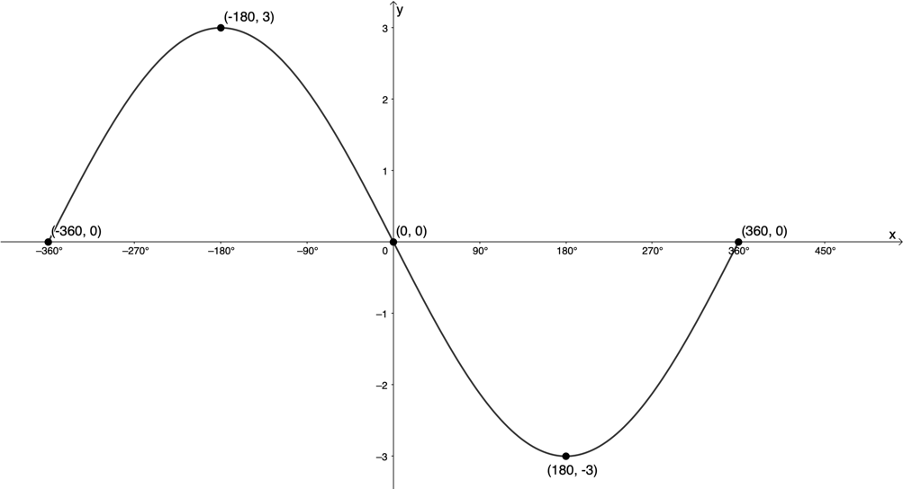
- Domain: [latex]\scriptsize \{x|x\in \mathbb{R},-{{360}^\circ}\le x\le {{360}^\circ}\}\text{ }[/latex]
Range:[latex]\scriptsize \{f(x)|f(x)\in \mathbb{R},-3\le f(x)\le 3\}\text{ }[/latex] - Turning points: [latex]\scriptsize (-{{180}^\circ},3)[/latex] and [latex]\scriptsize ({{180}^\circ},-3)[/latex]
- Amplitude is [latex]\scriptsize 3[/latex]
- Period is [latex]\scriptsize {{720}^\circ}[/latex]
Exercise 7.2
Sketch the following functions for the indicated intervals:
- [latex]\scriptsize y=-2\sin \displaystyle \frac{\theta }{2}[/latex] for [latex]\scriptsize -{{360}^\circ}\le \theta \le {{360}^\circ}[/latex]
- [latex]\scriptsize y=\sin \left( {-\displaystyle \frac{{3x}}{2}} \right)[/latex] for [latex]\scriptsize -{{180}^\circ}\le x\le {{180}^\circ}[/latex]
- [latex]\scriptsize y=\displaystyle \frac{1}{2}\sin 3\theta[/latex] for [latex]\scriptsize -{{180}^\circ}\le \theta \le {{180}^\circ}[/latex]
The full solutions are at the end of the unit.
Find the equation of a sine function of the form [latex]\scriptsize y=a\sin kx[/latex]
By examining the amplitude and period of a graph of the form [latex]\scriptsize y=a\sin kx[/latex], we can determine the values of [latex]\scriptsize a[/latex] and [latex]\scriptsize k[/latex].
Example 7.4
Given the following graph of the form [latex]\scriptsize y=a\sin kx[/latex], determine the values of [latex]\scriptsize a[/latex] and [latex]\scriptsize k[/latex].
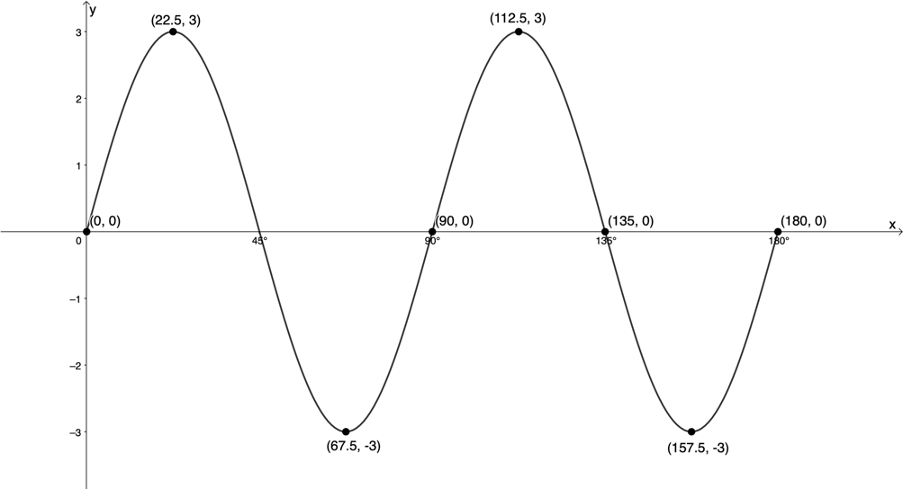
Solution
From the graph we can see that the amplitude is [latex]\scriptsize 3[/latex]. We can also see that the graph is not reflected about the x-axis. From zero, it rises to its maximum turning point in the same way as does the graph of [latex]\scriptsize y=\sin x[/latex]. Therefore, [latex]\scriptsize a=3[/latex] and [latex]\scriptsize y=3\sin kx[/latex].
The period is [latex]\scriptsize {{90}^\circ}[/latex].
[latex]\scriptsize \begin{align*}\text{Period}&=\displaystyle \frac{{{{{360}}^\circ}}}{{\left| k \right|}}\\{{90}^\circ}&=\displaystyle \frac{{{{{360}}^\circ}}}{{\left| k \right|}}\\\therefore \left| k \right|&=4\text{ }\end{align*}[/latex]
Because the graph is not reflected about the x-axis, [latex]\scriptsize k=4[/latex].
[latex]\scriptsize y=3\sin 4x[/latex]
Example 7.5
Given the following graph of the form [latex]\scriptsize y=a\sin kx[/latex], determine the values of [latex]\scriptsize a[/latex] and [latex]\scriptsize k[/latex].
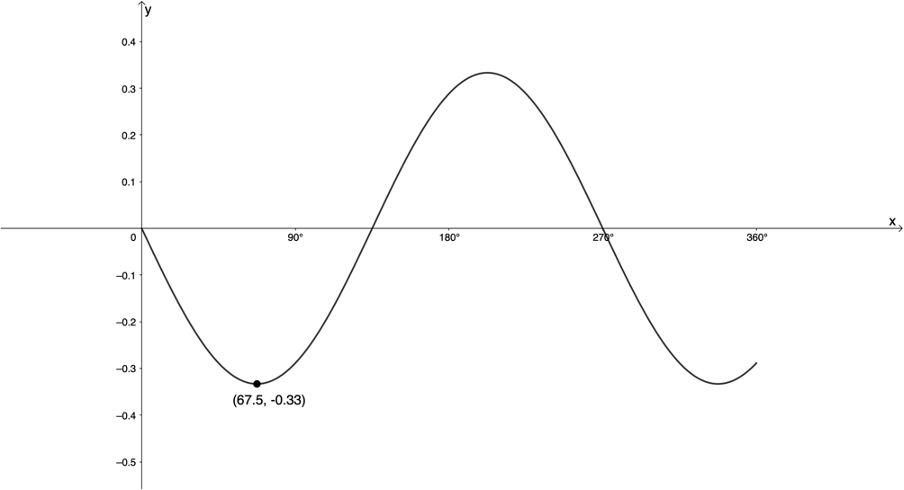
Solution
From the graph we can see that the amplitude is [latex]\scriptsize \displaystyle \frac{1}{3}[/latex]. We can also see that the graph is reflected about the x-axis. From zero, it falls to its minimum turning point unlike the graph of [latex]\scriptsize y=\sin x[/latex], which rises to its maximum turning point. Therefore, [latex]\scriptsize a=-\displaystyle \frac{1}{3}[/latex] and [latex]\scriptsize y=-\displaystyle \frac{1}{3}\sin kx[/latex].
[latex]\scriptsize \begin{align*}\text{Period}=\displaystyle \frac{{{{{360}}^\circ}}}{{\left| k \right|}}\\{{270}^\circ}=\displaystyle \frac{{{{{360}}^\circ}}}{{\left| k \right|}}\\\therefore \left| k \right|=\displaystyle \frac{{{{{360}}^\circ}}}{{{{{270}}^\circ}}}=\displaystyle \frac{4}{3}\text{ }\end{align*}[/latex]
[latex]\scriptsize y=-\displaystyle \frac{1}{3}\sin \left( {\displaystyle \frac{4}{3}x} \right)[/latex]
Note: that we could also assign the negative to the value of [latex]\scriptsize k[/latex] and state that the equation of the function is [latex]\scriptsize y=\displaystyle \frac{1}{3}\sin \left( {-\displaystyle \frac{4}{3}x} \right)[/latex]. Because [latex]\scriptsize \displaystyle -\sin x=\sin (-x)[/latex], [latex]\scriptsize -\displaystyle \frac{1}{3}\sin \left( {\displaystyle \frac{4}{3}x} \right)=\displaystyle \frac{1}{3}\sin \left( {-\displaystyle \frac{4}{3}x} \right)[/latex].
Exercise 7.3
Given the graph of the form [latex]\scriptsize y=a\sin kx[/latex]:
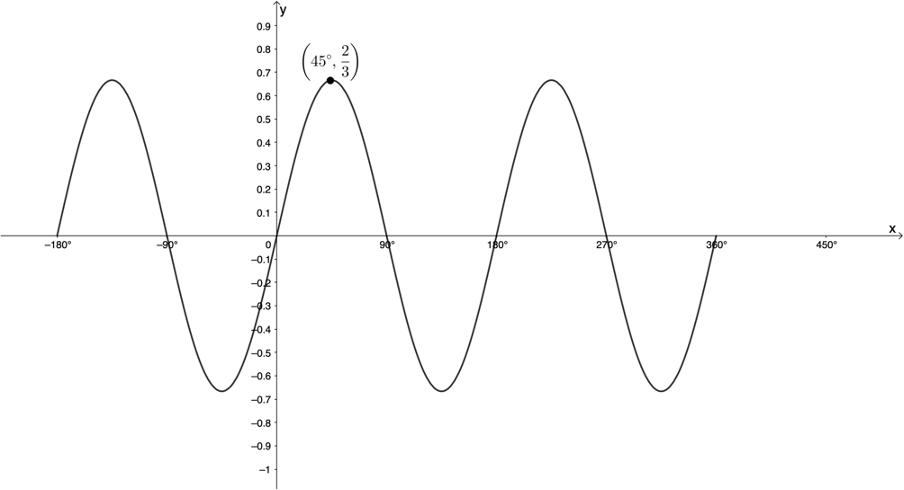
- Determine the values of [latex]\scriptsize a[/latex] and [latex]\scriptsize k[/latex].
- State the domain and range of the function.
The full solutions are at the end of the unit.
Summary
In this unit you have learnt the following:
- The effects of [latex]\scriptsize a[/latex] and [latex]\scriptsize k[/latex] on the sine graph of the form [latex]\scriptsize y=a\sin k\theta[/latex].
- How to sketch functions of the form [latex]\scriptsize y=a\sin k\theta[/latex].
- How to find the values of [latex]\scriptsize a[/latex] and [latex]\scriptsize k[/latex] from a given sine graph of the form [latex]\scriptsize y=a\sin k\theta[/latex].
Unit 7: Assessment
Suggested time to complete: 45 minutes
- Sketch the following functions for the given intervals:
- [latex]\scriptsize 3y=\sin \left( {-\displaystyle \frac{1}{3}x} \right)[/latex] for [latex]\scriptsize -{{720}^\circ}\le x\le {{360}^\circ}[/latex]
- [latex]\scriptsize g(x)=-4\sin 2x[/latex] for [latex]\scriptsize {{0}^\circ}\le x\le {{270}^\circ}[/latex]
- From the graph below of the form [latex]\scriptsize y=a\sin kx[/latex], determine the values of [latex]\scriptsize a[/latex] and [latex]\scriptsize k[/latex].
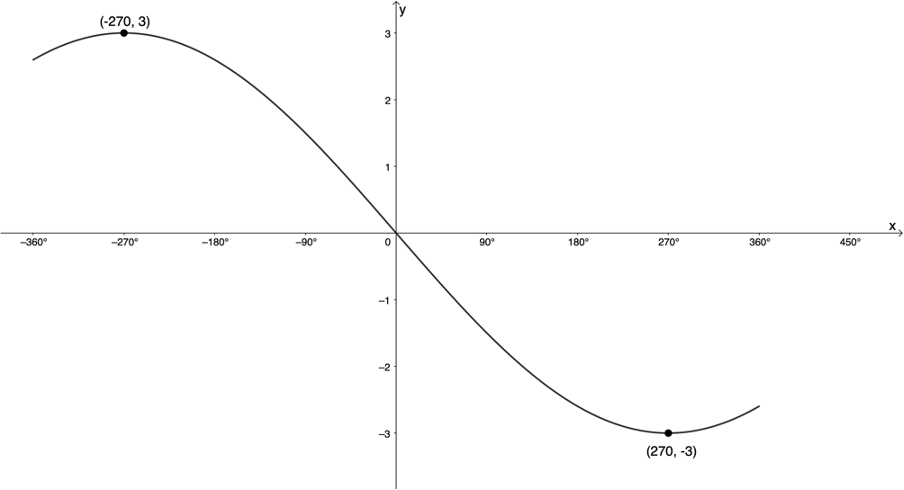
The full solutions are at the end of the unit.
Unit 7: Solutions
Exercise 7.1
- .
- [latex]\scriptsize y=\sin (3x)[/latex]
[latex]\scriptsize k=3[/latex]
[latex]\scriptsize \text{Period}=\displaystyle \frac{{{{{360}}^\circ}}}{{\left| 3 \right|}}=\displaystyle \frac{{{{{360}}^\circ}}}{3}={{120}^\circ}[/latex] - [latex]\scriptsize y=\sin \left( {-\displaystyle \frac{1}{2}x} \right)[/latex]
[latex]\scriptsize k=-\displaystyle \frac{1}{2}[/latex]
[latex]\scriptsize \text{Period}=\displaystyle \frac{{{{{360}}^\circ}}}{{\left| {-\displaystyle \frac{1}{2}} \right|}}=\displaystyle \frac{{{{{360}}^\circ}}}{{\displaystyle \frac{1}{2}}}={{720}^\circ}[/latex] - [latex]\scriptsize y=\sin \left( {\displaystyle \frac{7}{3}x} \right)[/latex]
[latex]\scriptsize k=\displaystyle \frac{7}{3}[/latex]
[latex]\scriptsize \text{Period}=\displaystyle \frac{{{{{360}}^\circ}}}{{\left| {\displaystyle \frac{7}{3}} \right|}}=\displaystyle \frac{{3\times {{{360}}^\circ}}}{7}={{154.29}^\circ}[/latex]
- [latex]\scriptsize y=\sin (3x)[/latex]
- .
- The period of the graph is [latex]\scriptsize {{120}^\circ}[/latex].
[latex]\scriptsize \begin{align*}\text{Period}=\displaystyle \frac{{{{{360}}^\circ}}}{{\left| k \right|}}\\{{120}^\circ}=\displaystyle \frac{{{{{360}}^\circ}}}{{\left| k \right|}}\\\therefore \left| k \right|=3\text{ }\end{align*}[/latex]
The graph is not reflected about the x-axis. Therefore, [latex]\scriptsize k \gt 0[/latex]. [latex]\scriptsize k=3[/latex]. - The period of the graph is [latex]\scriptsize {{270}^\circ}[/latex].
[latex]\scriptsize \begin{align*}\text{Period}=\displaystyle \frac{{{{{360}}^\circ}}}{{\left| k \right|}}\\{{270}^\circ}=\displaystyle \frac{{{{{360}}^\circ}}}{{\left| k \right|}}\\\therefore \left| k \right|=\displaystyle \frac{{{{{360}}^\circ}}}{{{{{270}}^\circ}}}=\displaystyle \frac{4}{3}\text{ }\end{align*}[/latex]
The graph is reflected about the x-axis. Therefore, [latex]\scriptsize k \lt 0[/latex]. [latex]\scriptsize k=-\displaystyle \frac{4}{3}[/latex]. - The period of the graph is [latex]\scriptsize {{540}^\circ}[/latex].
[latex]\scriptsize \begin{align*}\text{Period}=\displaystyle \frac{{{{{360}}^\circ}}}{{\left| k \right|}}\\{{540}^\circ}=\displaystyle \frac{{{{{360}}^\circ}}}{{\left| k \right|}}\\\therefore \left| k \right|=\displaystyle \frac{{{{{360}}^\circ}}}{{{{{540}}^\circ}}}=\displaystyle \frac{2}{3}\text{ }\end{align*}[/latex]
The graph is not reflected about the x-axis. Therefore, [latex]\scriptsize k \gt 0[/latex]. [latex]\scriptsize k=\displaystyle \frac{2}{3}[/latex].
- The period of the graph is [latex]\scriptsize {{120}^\circ}[/latex].
Exercise 7.2
- [latex]\scriptsize y=-2\sin \displaystyle \frac{\theta }{2}[/latex] for [latex]\scriptsize -{{360}^\circ}\le \theta \le {{360}^\circ}[/latex]
[latex]\scriptsize k=\displaystyle \frac{1}{2}[/latex]
[latex]\scriptsize \text{Period}=\displaystyle \frac{{{{{360}}^\circ}}}{{\left| k \right|}}=\displaystyle \frac{{{{{360}}^\circ}}}{{\left| {\displaystyle \frac{1}{2}} \right|}}={{720}^\circ}[/latex]
[latex]\scriptsize a=-2[/latex]. Amplitude is [latex]\scriptsize 2[/latex] and graph is reflected about the x-axis.[latex]\scriptsize \sin \theta[/latex] [latex]\scriptsize ({{0}^\circ},0)[/latex] [latex]\scriptsize ({{90}^\circ},1)[/latex] [latex]\scriptsize ({{180}^\circ},0)[/latex] [latex]\scriptsize ({{270}^\circ},-1)[/latex] [latex]\scriptsize ({{360}^\circ},0)[/latex] [latex]\scriptsize -2\sin \left( {\displaystyle \frac{\theta }{2}} \right)[/latex] [latex]\scriptsize ({{0}^\circ},0)[/latex] [latex]\scriptsize ({{180}^\circ},-2)[/latex] [latex]\scriptsize ({{360}^\circ},0)[/latex] [latex]\scriptsize ({{540}^\circ},2)[/latex] [latex]\scriptsize ({{720}^\circ},0)[/latex] 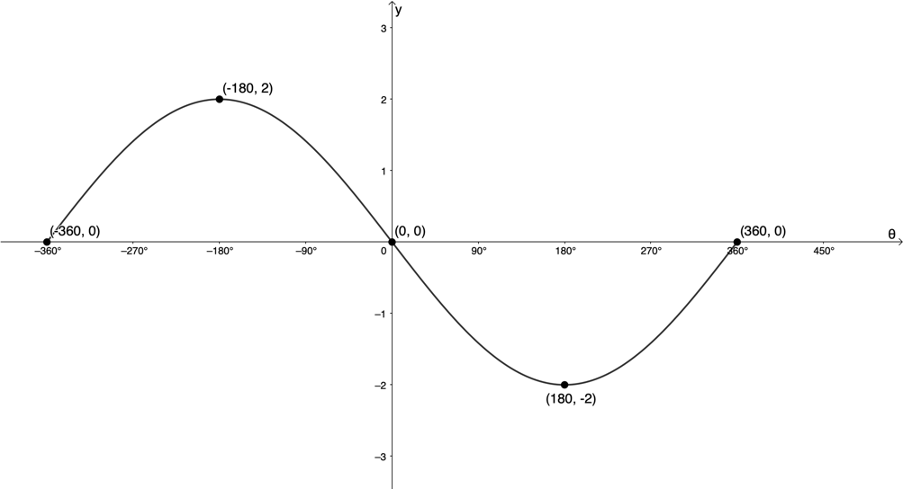
- [latex]\scriptsize y=\sin \left( {-\displaystyle \frac{{3x}}{2}} \right)[/latex] for [latex]\scriptsize -{{180}^\circ}\le x\le {{180}^\circ}[/latex]
[latex]\scriptsize k=-\displaystyle \frac{3}{2}[/latex]
[latex]\scriptsize \text{Period}=\displaystyle \frac{{{{{360}}^\circ}}}{{\left| k \right|}}=\displaystyle \frac{{{{{360}}^\circ}}}{{\left| {-\displaystyle \frac{3}{2}} \right|}}=\displaystyle \frac{{{{{360}}^\circ}}}{{\displaystyle \frac{3}{2}}}={{240}^\circ}[/latex]
[latex]\scriptsize k \lt 0[/latex]. Therefore, graph is reflected about the x-axis.
[latex]\scriptsize a=1[/latex]. Amplitude is [latex]\scriptsize 1[/latex].[latex]\scriptsize \sin x[/latex] [latex]\scriptsize ({{0}^\circ},0)[/latex] [latex]\scriptsize ({{90}^\circ},1)[/latex] [latex]\scriptsize ({{180}^\circ},0)[/latex] [latex]\scriptsize ({{270}^\circ},-1)[/latex] [latex]\scriptsize ({{360}^\circ},0)[/latex] [latex]\scriptsize \sin \left( {-\displaystyle \frac{3}{2}x} \right)[/latex] [latex]\scriptsize ({{0}^\circ},0)[/latex] [latex]\scriptsize ({{60}^\circ},-1)[/latex] [latex]\scriptsize ({{120}^\circ},0)[/latex] [latex]\scriptsize ({{180}^\circ},1)[/latex] [latex]\scriptsize ({{240}^\circ},0)[/latex] 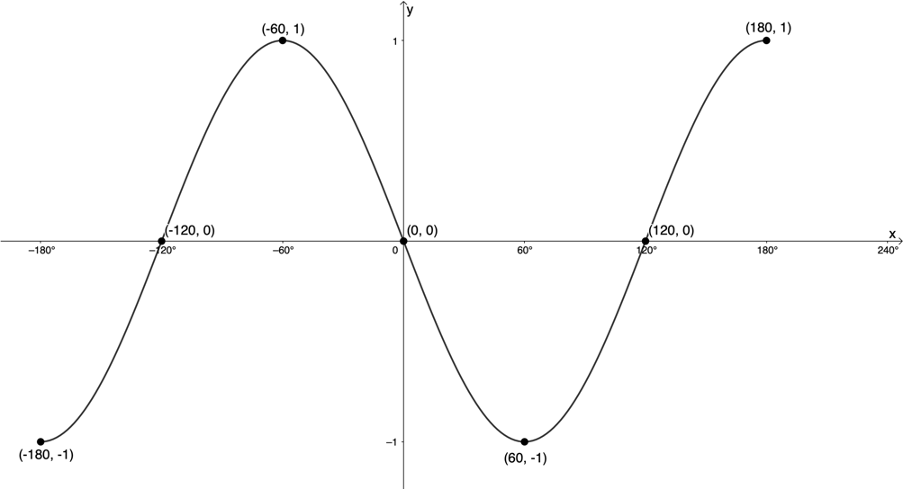
- [latex]\scriptsize y=\displaystyle \frac{1}{2}\sin 3\theta[/latex] for [latex]\scriptsize -{{180}^\circ}\le x\le {{180}^\circ}[/latex]
[latex]\scriptsize k=3[/latex]
[latex]\scriptsize \text{Period}=\displaystyle \frac{{{{{360}}^\circ}}}{{\left| k \right|}}=\displaystyle \frac{{{{{360}}^\circ}}}{{\left| 3 \right|}}={{120}^\circ}[/latex]
[latex]\scriptsize a=\displaystyle \frac{1}{2}[/latex]. Amplitude is [latex]\scriptsize \displaystyle \frac{1}{2}[/latex].[latex]\scriptsize \sin \theta[/latex] [latex]\scriptsize ({{0}^\circ},0)[/latex] [latex]\scriptsize ({{90}^\circ},1)[/latex] [latex]\scriptsize ({{180}^\circ},0)[/latex] [latex]\scriptsize ({{270}^\circ},-1)[/latex] [latex]\scriptsize ({{360}^\circ},0)[/latex] [latex]\scriptsize \displaystyle \frac{1}{2}\sin \left( {3\theta } \right)[/latex] [latex]\scriptsize ({{0}^\circ},0)[/latex] [latex]\scriptsize ({{30}^\circ},\displaystyle \frac{1}{2})[/latex] [latex]\scriptsize ({{60}^\circ},0)[/latex] [latex]\scriptsize ({{90}^\circ},-\displaystyle \frac{1}{2})[/latex] [latex]\scriptsize ({{120}^\circ},0)[/latex] 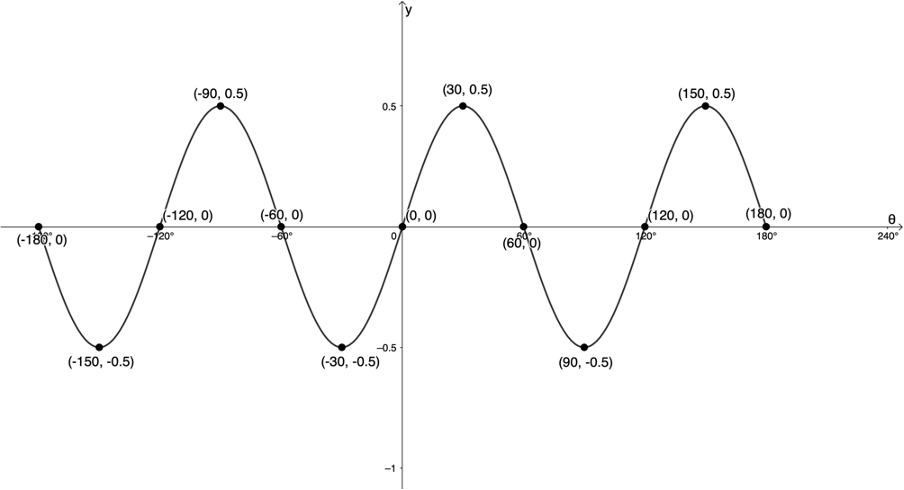
Exercise 7.3
- The amplitude of the function is [latex]\scriptsize \displaystyle \frac{2}{3}[/latex]and graph is not reflected about the x-axis. Therefore, [latex]\scriptsize a=\displaystyle \frac{2}{3}[/latex] and [latex]\scriptsize y=\displaystyle \frac{2}{3}\sin kx[/latex].
The period is [latex]\scriptsize {{180}^\circ}[/latex]. Therefore [latex]\scriptsize k=2[/latex].
[latex]\scriptsize y=\displaystyle \frac{2}{3}\sin 2x[/latex] - Domain: [latex]\scriptsize \{x|x\in \mathbb{R},\text{ }-{{180}^\circ}\le x\le {{360}^\circ}\}\text{ }[/latex]
Range: [latex]\scriptsize \{y|y\in \mathbb{R},\text{ }-\displaystyle \frac{2}{3}\le x\le \displaystyle \frac{2}{3}\}\text{ }[/latex]
Unit 7: Assessment
- .
- [latex]\scriptsize 3y=\sin \left( {-\displaystyle \frac{1}{3}x} \right)[/latex] for [latex]\scriptsize -{{720}^\circ}\le x\le {{360}^\circ}[/latex]
[latex]\scriptsize \begin{align*}3y & =\sin \left( {-\displaystyle \frac{1}{3}x} \right)\\\therefore y & =\displaystyle \frac{1}{3}\sin \left( {-\displaystyle \frac{1}{3}x} \right)\end{align*}[/latex]
[latex]\scriptsize k=-\displaystyle \frac{1}{3}[/latex]. Therefore, [latex]\scriptsize \text{period}=\displaystyle \frac{360^\circ}{\left | \displaystyle \frac{1}{3} \right |}=1~080^\circ[/latex].
[latex]\scriptsize k \lt 0[/latex]. Therefore, the graph is reflected about the x-axis.
[latex]\scriptsize a=\displaystyle \frac{1}{3}[/latex]. Therefore, amplitude is [latex]\scriptsize \displaystyle \frac{1}{3}[/latex].[latex]\scriptsize \sin \theta[/latex] [latex]\scriptsize ({{0}^\circ},0)[/latex] [latex]\scriptsize ({{90}^\circ},1)[/latex] [latex]\scriptsize ({{180}^\circ},0)[/latex] [latex]\scriptsize ({{270}^\circ},-1)[/latex] [latex]\scriptsize ({{360}^\circ},0)[/latex] [latex]\scriptsize \displaystyle \frac{1}{3}\sin \left( {-\displaystyle \frac{1}{3}x} \right)[/latex] [latex]\scriptsize ({{0}^\circ},0)[/latex] [latex]\scriptsize ({{270}^\circ},-\displaystyle \frac{1}{3})[/latex] [latex]\scriptsize \displaystyle ({{540}^\circ},0)[/latex] [latex]\scriptsize ({{810}^\circ},\displaystyle \frac{1}{3})[/latex] [latex]\scriptsize (1\ {{080}^\circ},0)[/latex] 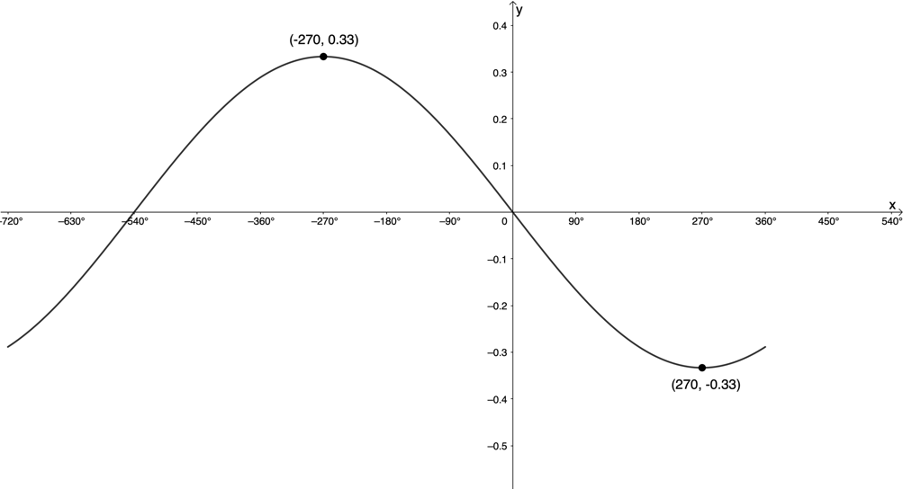
- [latex]\scriptsize g(x)=-4\sin 2x[/latex] for [latex]\scriptsize {{0}^\circ}\le x\le {{270}^\circ}[/latex]
[latex]\scriptsize k=2[/latex]. Therefore, [latex]\scriptsize \text{period}=\displaystyle \frac{360^\circ}{\left | 2 \right |}=180^\circ[/latex].
[latex]\scriptsize a=-4[/latex]. Therefore, amplitude is [latex]\scriptsize 4[/latex] and the graph is reflected about the x-axis.[latex]\scriptsize \sin \theta[/latex] [latex]\scriptsize ({{0}^\circ},0)[/latex] [latex]\scriptsize ({{90}^\circ},1)[/latex] [latex]\scriptsize ({{180}^\circ},0)[/latex] [latex]\scriptsize ({{270}^\circ},-1)[/latex] [latex]\scriptsize ({{360}^\circ},0)[/latex] [latex]\scriptsize -4\sin 2x[/latex] [latex]\scriptsize ({{0}^\circ},0)[/latex] [latex]\scriptsize ({{45}^\circ},-4)[/latex] [latex]\scriptsize \displaystyle ({{90}^\circ},0)[/latex] [latex]\scriptsize ({{135}^\circ},4)[/latex] [latex]\scriptsize ({{180}^\circ},0)[/latex] 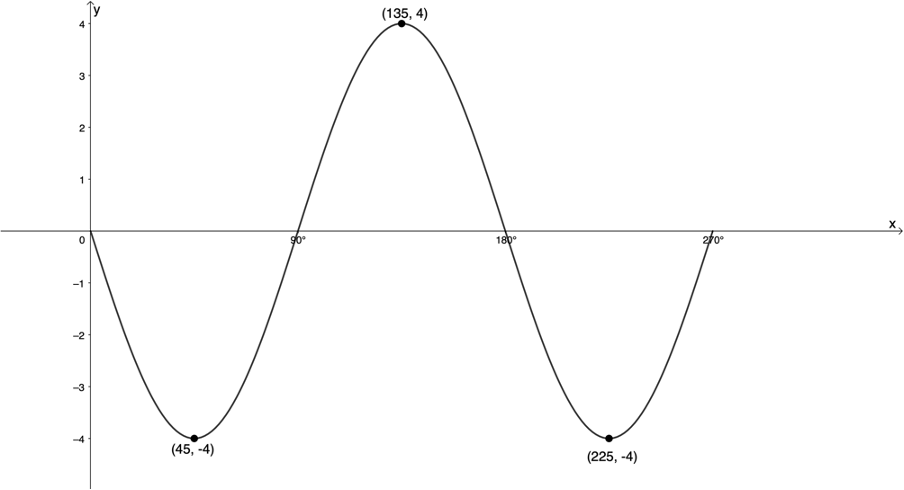
- [latex]\scriptsize 3y=\sin \left( {-\displaystyle \frac{1}{3}x} \right)[/latex] for [latex]\scriptsize -{{720}^\circ}\le x\le {{360}^\circ}[/latex]
- The amplitude is [latex]\scriptsize 3[/latex] and the graph is reflected about the x-axis. Therefore, [latex]\scriptsize a=-3[/latex] and [latex]\scriptsize y=-3\sin kx[/latex].
The graph completes half a period between [latex]\scriptsize -{{270}^\circ}[/latex] and [latex]\scriptsize {{270}^\circ}[/latex]. Therefore, the period is [latex]\scriptsize 2\times {{540}^\circ}=1 \ {{080}^\circ}[/latex].
[latex]\scriptsize \begin{align*}\text{Period}=\displaystyle \frac{{{{{360}}^\circ}}}{{\left| k \right|}}\\1\ {{080}^\circ}=\displaystyle \frac{{{{{360}}^\circ}}}{{\left| k \right|}}\\\therefore \left| k \right|=\displaystyle \frac{{{{{360}}^\circ}}}{{1\ {{{080}}^\circ}}}=\displaystyle \frac{1}{3}\text{ }\end{align*}[/latex]
[latex]\scriptsize y=-3\sin \left( {\displaystyle \frac{1}{3}x} \right)[/latex]
Media Attributions
- figure1 © Geogebra is licensed under a CC BY-SA (Attribution ShareAlike) license
- figure2 © Geogebra is licensed under a CC BY-SA (Attribution ShareAlike) license
- figure3 © Geogebra is licensed under a CC BY-SA (Attribution ShareAlike) license
- figure4 © Geogebra is licensed under a CC BY-SA (Attribution ShareAlike) license
- figure5 © Geogebra is licensed under a CC BY-SA (Attribution ShareAlike) license
- figure6 © Geogebra is licensed under a CC BY-SA (Attribution ShareAlike) license
- figure7 © DHET is licensed under a CC BY (Attribution) license
- figure8 © Geogebra is licensed under a CC BY-SA (Attribution ShareAlike) license
- figure9 © Geogebra is licensed under a CC BY-SA (Attribution ShareAlike) license
- figure10 © Geogebra is licensed under a CC BY-SA (Attribution ShareAlike) license
- figure11 © Geogebra is licensed under a CC BY-SA (Attribution ShareAlike) license
- figure12 © DHET is licensed under a CC BY (Attribution) license
- exercise7.1Q2a © Geogebra is licensed under a CC BY-SA (Attribution ShareAlike) license
- exercise7.1Q2b © Geogebra is licensed under a CC BY-SA (Attribution ShareAlike) license
- exercise7.1Q2c © Geogebra is licensed under a CC BY-SA (Attribution ShareAlike) license
- figure13 © Geogebra is licensed under a CC BY-SA (Attribution ShareAlike) license
- example7.2 © Geogebra is licensed under a CC BY-SA (Attribution ShareAlike) license
- example7.3 © Geogebra is licensed under a CC BY-SA (Attribution ShareAlike) license
- example7.4 © Geogebra is licensed under a CC BY-SA (Attribution ShareAlike) license
- example7.5 © Geogebra is licensed under a CC BY-SA (Attribution ShareAlike) license
- exercise7.3 © Geogebra is licensed under a CC BY-SA (Attribution ShareAlike) license
- assessmentQ2 © Geogebra is licensed under a CC BY-SA (Attribution ShareAlike) license
- exercise7.2A1 © Geogebra is licensed under a CC BY-SA (Attribution ShareAlike) license
- exercise7.2A2 © Geogebra is licensed under a CC BY-SA (Attribution ShareAlike) license
- exercise7.2A3 © Geogebra is licensed under a CC BY-SA (Attribution ShareAlike) license
- assessmentA1a © Geogebra is licensed under a CC BY-SA (Attribution ShareAlike) license
- assessmentA1b © Geogebra is licensed under a CC BY-SA (Attribution ShareAlike) license
